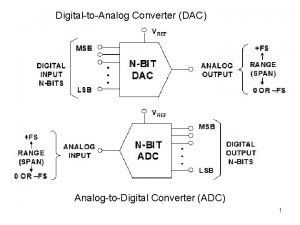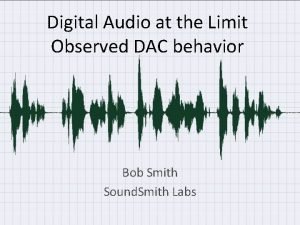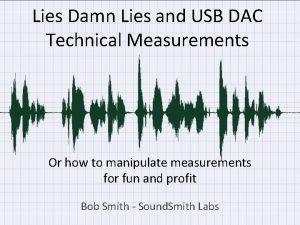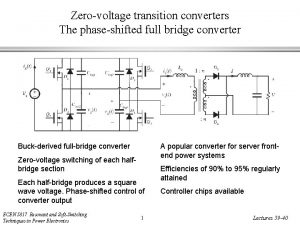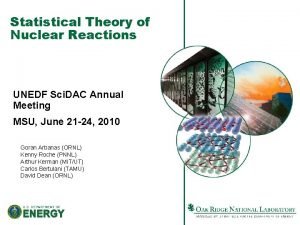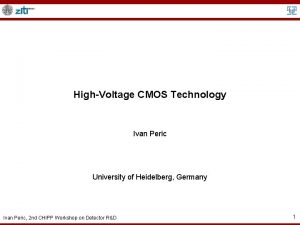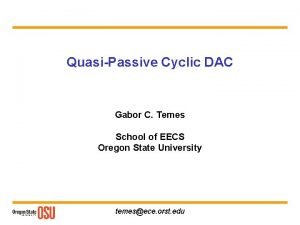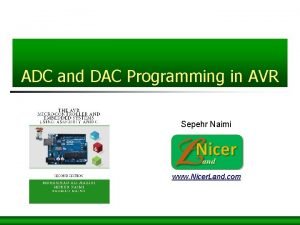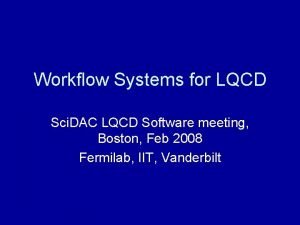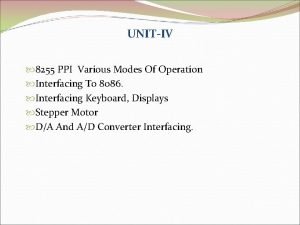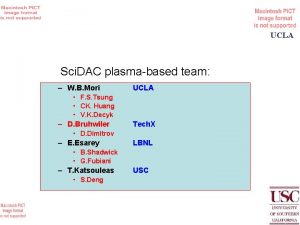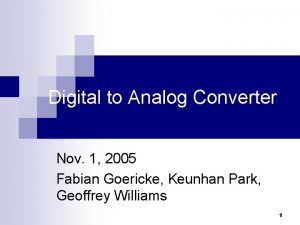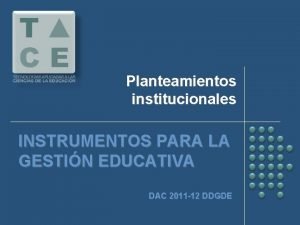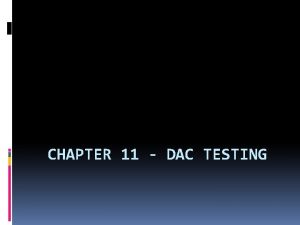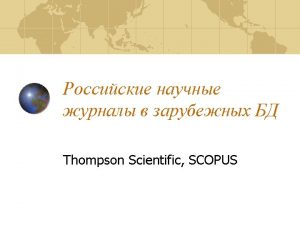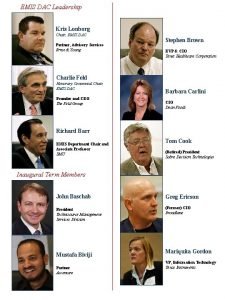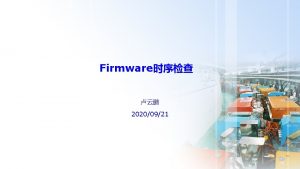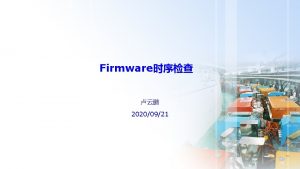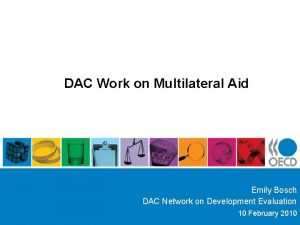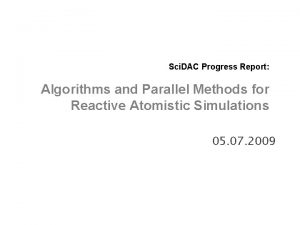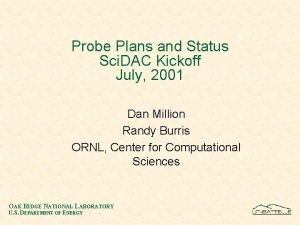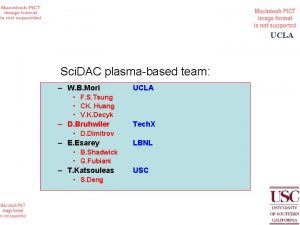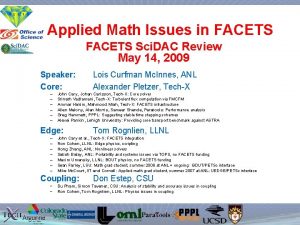Sci DAC at 10 Sci DAC 2011 11





































- Slides: 37

Sci. DAC at 10 Sci. DAC 2011 11 July 2011 Dr. Patricia M. Dehmer Deputy Director for Science Programs Office of Science, U. S. Department of Energy http: //science. energy. gov/sc-2/presentations-and-testimony/

Secretary Steven Chu Advanced Research Projects Agency – Energy Arun Majumdar Deputy Secretary Daniel B. Poneman Under Secretary for Nuclear Security/Administrator for National Nuclear Security Administration Thomas P. D’Agostino Under Secretary for Science Under Secretary Arun Majumdar (A) Steven E. Koonin Office of Science Defense Nuclear Nonproliferation William Brinkman Patricia Dehmer Defense Programs Naval Reactors Counter-terrorism Defense Nuclear Security Emergency Operations Fossil Energy Basic Energy Sciences High Energy Physics Harriet Kung Mike Procario(A) Advanced Scientific Computing Research Daniel Hitchcock (A) Nuclear Physics Biological & Environmental Research Sharlene Weatherwax Fusion Energy Sciences SBIR/STTR Workforce Develop. for Teachers & Scientists Patricia Dehmer (A) Manny Oliver Energy Efficiency & Renewable Energy Tim Hallman Nuclear Energy Electricity Delivery & Energy Reliability Ed Synakowski Sci. DAC @ 10 2

The World Before Sci. DAC The Scientific Simulation Initiative (SSI) (submitted to Congress February 1999) SSI – “It is now possible to obtain computational capabilities 100 times faster than currently in common use through the application of technologies developed for the Accelerated Strategic Computing Initiative (ASCI)*. … The mission of the SSI is to further develop and employ the emerging generation of very high performance computers as major tools for scientific inquiry. ” SSI included: § § Advanced computing (terascale computers) High performance networks Computer science and enabling technology research Investments in scientific applications SSI applications: § Two mission critical, time critical applications: global systems and combustion systems. These apps were to help define hardware and software. § A small number of basic science applications to be selected by peer review. *Established in 1995, ASCI supports the development of computer simulation capabilities to analyze and predict the performance, safety, and reliability of nuclear weapons and to certify their functionality. Sci. DAC @ 10 3

SSI: The FY 2000 Senate Report May 27, 1999 The Committee recommendation does not include the $70, 000 requested for the Department’s participation in the Scientific Simulation Initiative. Sci. DAC @ 10 4

SSI: The FY 2000 House Report July 23, 1999 The Committee recommendation …does not include funds for the Scientific Simulation Initiative (SSI) … The budget justification for SSI failed to justify the need to establish a second supercomputing program in the Department of Energy. … The ASCI program, for which Congress is providing more than $300, 000 per year, seeks to build and operate massively parallel computers with a performance goal of 100 Tera. Ops by 2004. The proposed SSI program has a goal of building and operating a separate, yet similar, program dedicated exclusively to domestic purposes. …The Committee appreciates the advantages of modeling and having computing capability to analyze complex problems. The Committee would like to work with the Department to get better answers to questions it has about this new proposal. The Committee looks forward to further discussions to identify a program that has mutually supportable budget and program plans. Sci. DAC @ 10 5

SSI: The FY 2000 Conference Report September 27, 1999 The conference agreement includes $132, 000, instead of $143, 000 as provided by the House or $129, 000 as provided by the Senate. The conferees strongly support the Department’s current supercomputer programs including ASCI, NERSC, and modeling programs. The conferees urge the Department to submit a comprehensive plan for a non-Defense supercomputing program that reflects a unique role for the Department in this multi-agency effort and a budget plan that indicates spending requirements over a five-year budget cycle. Sci. DAC @ 10 6

And then there was Sci. DAC On March 30, 2000, SC submitted a plan for scientific computing to the EWD Subcommittees of the Appropriations Committees of the U. S. Congress. The plan, “Scientific Discovery through Advanced Computing, ” outlined a fiveyear program to develop the Scientific Computing Software and Hardware Infrastructure needed to use terascale computers to advance research programs in basic energy sciences, biological and environmental research, fusion energy sciences, and high energy and nuclear physics. Sci. DAC @ 10 7

Sci. DAC Goals (2001) § Create scientific codes that take advantage of terascale computers. § Create mathematical and computing systems software to efficiently use terascale computers. § Create a collaboratory environment to enable geographically separated researchers to work together and to facilitate remote access to facilities and data. Sci. DAC @ 10 8

Advancing Climate Simulation Climate simulation on terascale computers will improve our understanding of global climate and enable the study of regional scale impacts of global change. DOE’s program is an element of the U. S. Global Change Research Program. DOE’s program is designed to make full use of the computing capabilities provided by computers capable of 10 to 100 teraflops. The new program will provide greater certainty in predictions of future climates at both global and regional scales. It will also provide detailed information on the effects of climate change, including many not now possible, e. g. , changes in topical storm frequency. Sci. DAC @ 10 9

Advancing Materials Sciences Prediction of the magnetic properties of materials will enable the design of stronger, lighter magnets and new materials for magnetic data storage and recording. Scientists recently reported a break-through in calculating the magnetic properties of materials. Combining modeling advances with the most powerful DOE-SC computer, DOE scientists were able to predict the effect of temperature on the magnetic moment of a crystal of iron. This is the first step to predicting the performance of magnets at typical operating temperatures. These simulations won the 1998 Gordon Bell prize in supercomputing for the fastest 10 Sci. DAC @ 10 scientific application.

Advancing Structural Genomics DOE is involved in both the Human Genome Project and the Microbial Genome Project. These projects are laying the foundation for a revolution in human health and biotechnology. To develop more effective drugs or redesign microbes for bioremediation, scientists must determine the structures and elucidate the functions of the proteins encoded in DNA. Determining the structure of a single protein is a time-consuming process and not always successful. There approximately 140, 000 proteins in the human body alone. Advances in scientific computing, coupled with DOE’s national light sources, will be critical for predicting Sci. DAC @ 10 protein structures. 11

Advancing Plasma Physics Predicting and controlling turbulence is of fundamental scientific interest as well as critically important for developing viable magnetic fusion devices Using DOE-SC’s existing computing capabilities and new mathematical techniques, scientists recently performed threedimensional simulations of microturbulence with parameters appropriate for present-day fusion plasmas. These simulations, for the first time, reproduced the major features of turbulent transport observed in the core of tokamaks. With increased computing power, it will be possible to simulate turbulent transport under realistic reactor-relevant plasma conditions Sci. DAC @ 10 12

Advancing Accelerator Physics Increased capabilities in accelerator physics simulation will enable improved designs and reduce cost and risk of nextgeneration accelerators. In past five years our ability to model particle beam dynamics in accelerators has increased dramatically —leading, for the first time, to reliable prediction of “beam halos” that limit the performance of accelerators. Greatly increased computer capability will l Coupling of accelerator subsystems, e. g. , the particle enable: beam and electromagnetic field l Exploration of advanced concepts to push the frontiers of accelerator science HPC simulation of intense beam exhibits ultra-low density beam halo Sci. DAC @ 10 13

Progress in Computational Science Molecular Calculations Hexadecane C 16 H 34 Catalysts (complex) Molecular Complexity Octane C 8 H 18 Computation: 275. million equations (non-linear) 30. quadrillion arithmetic operations Ethane 16. days for complete calculation C 2 H 6. (0. 25 teraflops computer) Methane CH 4 CH Computing Power (Peak) 1970 1980 1990 2000 2010 2020 2030 ? ? 0. 0001 0. 002 0. 5 1, 000 ? ? ? Hexadecane, aka cetane, ignites easily under compression. All other hydrocarbons in diesel fuel are indexed to cetane as to how well they ignite under compression. Sci. DAC @ 10 14

Dramatic Advances in Computing Terascale Today, Petascale Tomorrow ( 2001) IBM “Blue Gene” Innovative Designs Peak Teraflops 1, 000 MICROPROCESSORS of e Us m d e is as llel e r ra Inc Pa 100 2 x increase in microprocessor speeds every 18 -24 months (“Moore’s Law”) 10 PARALLELISM es nc dva c pro o r c Mi 1 0. 1 1996 More and more processors being used on single problem or A s s e INNOVATIVE DESIGNS 1998 2000 2002 2004 2006 Processors-in-Memory HTMT Sci. DAC @ 10 15

Peak Performance and Real Performance Diverging 1, 000 Peak Performance is skyrocketing § In past 10 years, peak performance has increased 100 x; in next 5 years, it will increase 1000 x Peak Performance 100 § But efficiency has declined from 40 -50% on vector supercomputers of 1990 s to as little as 5 -10% on parallel supercomputers of today § Efficiency on tomorrow’s supercomputers? Research challenge is software Teraflops Real Performance is increasing Software Challenge 10 1 Real Performance § Scientific codes to model and simulate physical processes and systems § Computing and math software to enable use of advanced computers for scientific applications 0. 1 1996 2000 2004 Sci. DAC @ 10 16

The Software Challenge “vector” “parallel” 100 Real Teraflops ideal Performance On “vector” machines, scientific codes realized 40 -50% of peak performance On “parallel” machines, existing scientific codes realize as little as 510% of peak performance 10 1 0. 1 Real Performance 0. 01 0. 1 1 10 100 Peak Teraflops Sci. DAC @ 10 17

Changing Memory Hierarchies Create Technical Challenges Today 1000 Processors Tomorrow 5000 Processors Access Times for 1 Word from memory: ~ 1 CPU cycle CPU ~ 100 CPU cycles Cache Interconnect Fabric CPU Cache CPU Three Levels of Memory Access times: 1 Word/ CPU cycle to 1 Word/1000 CPU cycles CPU Vector Register Node Memory Cache 1 * 1 Word = 1 piece of data Cache 2 2 2 Interconnect Fabric CPU One Level of Memory Access Time: ~ 1 Word* / CPU cycle Cache 2 Cache 1 1 Cache 1 Vector Register Cache 1 1 CPU Node Memory Shared Memory Cache 1 ~ 1000 CPU cycles CPU Node Memory CPU Vector Register Node Memory CPU Cache 2 Vector Register CPU Cache 2 2 The Old Days - c. 1990 Few Processors Four Levels of Memory Access times: 1 Word/ CPU cycle to 1 Word/10, 000 CPU cycles Sci. DAC @ 10 18

Sci. DAC Investment Strategy, Year #1 Scientific Challenge Teams (+$20. 0 M) BES Challenges BER Challenges FES Challenges HENP Challenges Enabling Technology (+$25. 0 M) Numerical Algorithms Scientific Data Management Performance Tuning Tools Operating System Enhancements ESnet Computing Hardware (+$12. 3 M) Flagship, Topical, and Experimental Computing Facilities Collaboratory Software Infrastructure (+$10. 1 M) Computational Science Graduate Fellowship Program (+$2. 0 M) Sci. DAC @ 10 19

Topology of SC and ASCI Programs Open Networks Open Computers Broad Scientific Applications Community Codes Fully Integrated Teams Secure Network Classified Computers Classified Applications ASCI Program: Non DP Laboratories SC Program: Universities “The Team” LANL LLNL SNL NNSA Laboratories Sci. DAC @ 10 20

The Campaign for Sci. DAC (~20 Hill contacts, mostly personal visits in 2 months) Sci. DAC @ 10 21

Sci. DAC in One Page Sci. DAC @ 10 22


The FY 2001 Outcome Conference Report: October 18, 2000 Sci. DAC @ 10 24

The FY 2001 Outcome Sci. DAC @ 10 25

But the joy was short lived, because … … on March 11, 2002, the Earth Simulator, developed by the Japanese government, officially opened. The ES was a highly parallel vector supercomputer system for running global climate models to study global warming and solid earth geophysics. The ES ran simulations of global climate in both the atmosphere and the oceans to a resolution of 10 km. Its performance on the LINPACK benchmark was 35. 86 TFLOPS, which was almost five times faster than ASCI White. Sci. DAC @ 10 26

And DOE responded with the Leadership Computing Facilities Argonne Leadership Computing Facility Oak Ridge Leadership Computing Facility In FY 2012, the Argonne LCF will be upgraded with a 10 petaflop IBM Blue Gene/Q. The Oak Ridge LCF will continue site preparations for a system expected in FY 2013 that will be 5 -10 times more capable than the Cray XT-5. Nuclear Reactor Simulation Fusion Plasmas § The Cray XT 5 ("Jaguar") at ORNL and the IBM Blue Gene/P ("Intrepid") at ANL will provide ~2. 3 billion processor hours in FY 12 to address science and engineering problems that defy traditional methods of theory and experiment and that require the most advanced computational power. § Peer reviewed projects are chosen to advance science, speed innovation, and strengthen industrial competitiveness. § Demand for these machines has grown each year, requiring upgrades of both. § Among the topics in FY 2011: § § Advancing materials for lithium air batteries, solar cells, and superconductors Exploring carbon sequestration Improving combustion in fuel-efficient, near-zero-emissions systems Understanding how turbulence affects the efficiency of aircraft and other transportation systems § Designing next-generation nuclear reactors and fuels and extending the life of aging reactors § Developing fusion energy systems § Understanding the roles of ocean, atmosphere, land, and ice in climate change Nanoscale Science Biofuels Energy Storage Materials Turbulence Sci. DAC @ 10 27

Sci. DAC 1 Successes § Sci. DAC teams created first laboratoryscale flame simulation in three dimensions to better understand combustion which provides 80% of the energy used in the U. S. § Magnetic fusion scientists and applied mathematicians simulated techniques for re-fueling fusion reactors § Teams developed new methods for simulating improvements in future particle accelerators § Partnerships improved effectiveness of scientific applications codes between 275% to over 10, 000% Hydroxyl radical in a turbulent jet flame § The Sci. DAC data mining tool Sapphire awarded a 2006 R&D 100 award Sci. DAC @ 10 28

Stress Corrosion Cracking Molecular Dynamics Simulation Reveals Mechanisms of Nickel Fracture simulations for nanocrystalline nickel without and with amorphous sulfide grain- boundary phases, showing ductile, transgranular tearing and brittle, intergranular cleavage. § The performance and lifetime of materials used in nuclear technology and in advanced power generation are severely limited by corrosive environments and extreme conditions. § Premature failure of materials can result from undetected stress corrosion cracking. § Annually, corrosion costs about 3% of the U. S. gross domestic product. § 48 -million-atom simulation on Argonne Leadership Computing Facility showed a link between sulfur impurities segregated at grain boundaries of nickel and embrittlement. An order-of-magnitude reduction in grain-boundary shear strength, combined with tensilestrength reduction, allows the crack tip to always find an easy propagation path in this configuration. This mechanism explains an experimentally observed crossover from microscopic fracture to macroscopic cracks due to sulfur impurities. § P. Vashishta (USC) Sci. DAC @ 10 29

Sci. DAC 1 Sci. DAC 2 The Sci. DAC program was re-competed in FY 2006 Goals: § Create comprehensive, scientific computing software infrastructure to enable scientific discovery in the physical, biological, and environmental sciences at the petascale § Develop a new generation of data management and knowledge discovery tools for large data sets (obtained from scientific user facilities and simulations) § >230 proposals received requesting approximately $1 B Sci. DAC @ 10 30

What’s next? Sci. DAC July 12, 2010 31

Why Exascale? Combustion Models Coupling Biofuels with Turbulence Exaflops Large-Eddy Simulation (LES) Petaflops Teraflops Gigaflops Quantum chemical Kinetics Simulations Direct Numerical Simulation (DNS) ls ho o c l Unsteady Laminar Flame Simulations A 4) u al f n atio d un Fo els se Die Bio Methyl Decanoate Methyl Butanoate Butanol Turbulent Flame Experiments Di-methyl Ether 1 -C (C Ethanol Mechanism Validation Experiments Ethylene Methane Syngas Hydrogen ls Sub-Model Development Laminar Flame/Ignition Experiments Chemical Kinetics Experiments 32

Investments for Exascale Computing Opportunities to Accelerate the Frontiers of Science through HPC Why Exascale? DOE Activities will: § SCIENCE: Computation and simulation advance knowledge in science, energy, and national security; numerous S&T communities and Federal Advisory groups have demonstrated the need for computing power 1, 000 times greater than we have today. § Leverage new chip technologies from the private sector to bring exascale capabilities within reach in terms of cost, feasibility, and energy utilization by the end of the decade; § Support research efforts in applied mathematics and computer science to develop libraries, tools, and software for these new technologies; § Create close partnerships with computational and computer scientists, applied mathematicians, and vendors to develop exascale platforms and codes cooperatively. § U. S. LEADERSHIP: The U. S. has been a leader in high performance computing for decades. U. S. researchers benefit from open access to advanced computing facilities, software, and programming tools. § BROAD IMPACT: Achieving the power efficiency, reliability, and programmability goals for exascale will have dramatic impacts on computing at all scales–from PCs to midrange computing and beyond. 33

Final thought … Expect the unexpected from new tools Sci. DAC July 12, 2010 34

Nature Publishes First Bioimaging Results from the LCLS The World’s First Hard X-ray Laser Within 6 months of completion, LCLS is being used to study a wide array of science topics, including: § § Hollow atoms Magnetic materials Structure of biomolecules in nano-crystals Single shot images of viruses and whole cells Sci. DAC @ 10 35

Femtosecond X-ray Protein Nanocrystallography Nanocrystals flow in their buffer solution in a gas-focused, 4 -mm-diameter jet at a velocity of 10 m/sec perpendicular to the pulsed X-ray FEL beam that is focused on the jet. Chapman, H. N. , et al. Nature, Feb 3 rd, 2011. Sci. DAC @ 10 36

Femtosecond X-ray Protein Nanocrystallography § Photosystem I plays key role in photosynthesis. § Difficult to crystallize and use standard x-ray crystallography to obtain structure. § Single shot images from Single shot diffraction pattern LCLS of nanocrystals used to build up full 3 -D diffraction pattern. Combined 3 D diffraction pattern § Low resolution (~9 Å) shows structural details (e. g. , helix density). § High resolution image Reconstructed 3 -D Structure subsequently taken Chapman, H. N. , et al. Nature, Feb 3 rd, 2011. Sci. DAC @ 10 37
 Dac assessment social work example
Dac assessment social work example Adc inl dnl calculation
Adc inl dnl calculation National semiconductor adc 0801 menggunakan prinsip
National semiconductor adc 0801 menggunakan prinsip Mousai msd 192 dac
Mousai msd 192 dac Dac amortization
Dac amortization Violectric dac v800
Violectric dac v800 Dac certified disciplined agilist (cda)
Dac certified disciplined agilist (cda) Buck converters
Buck converters Adc and dac interfacing with 8051
Adc and dac interfacing with 8051 8255 interfacing with 8085
8255 interfacing with 8085 Dac theory
Dac theory Nie mam nic co bym mógł tobie dać tekst
Nie mam nic co bym mógł tobie dać tekst Nda full dac
Nda full dac 4-bit dac
4-bit dac Dac vs rbac
Dac vs rbac Dac.db
Dac.db Gabor c. temes
Gabor c. temes Dac atmega
Dac atmega Disadvantages of weighted resistor dac
Disadvantages of weighted resistor dac Mac mac o kok dac
Mac mac o kok dac Pengertian adc dan dac
Pengertian adc dan dac Binary weighted resistor dac
Binary weighted resistor dac Convertitore analogico digitale funzionamento
Convertitore analogico digitale funzionamento Dac villers bret
Dac villers bret Adc and dac interfacing with 8051
Adc and dac interfacing with 8051 Dac&fw full form
Dac&fw full form Ltc1661 spi dac
Ltc1661 spi dac Dac
Dac What is the workflow for dac?
What is the workflow for dac? Nda full dac
Nda full dac Stepper motor interface with 8255
Stepper motor interface with 8255 Ucla dac
Ucla dac C-dac esign service
C-dac esign service Binary weighted resistor dac
Binary weighted resistor dac Dac carrasco
Dac carrasco Ubi dac
Ubi dac Percentage resolution of dac
Percentage resolution of dac Dac testing methods
Dac testing methods

